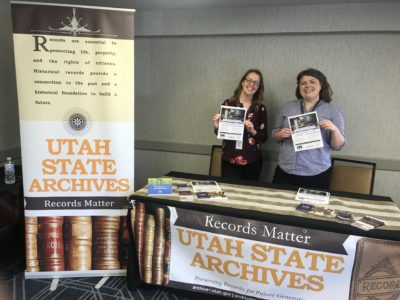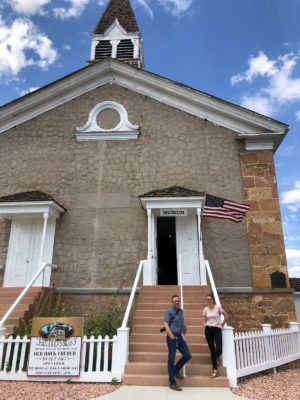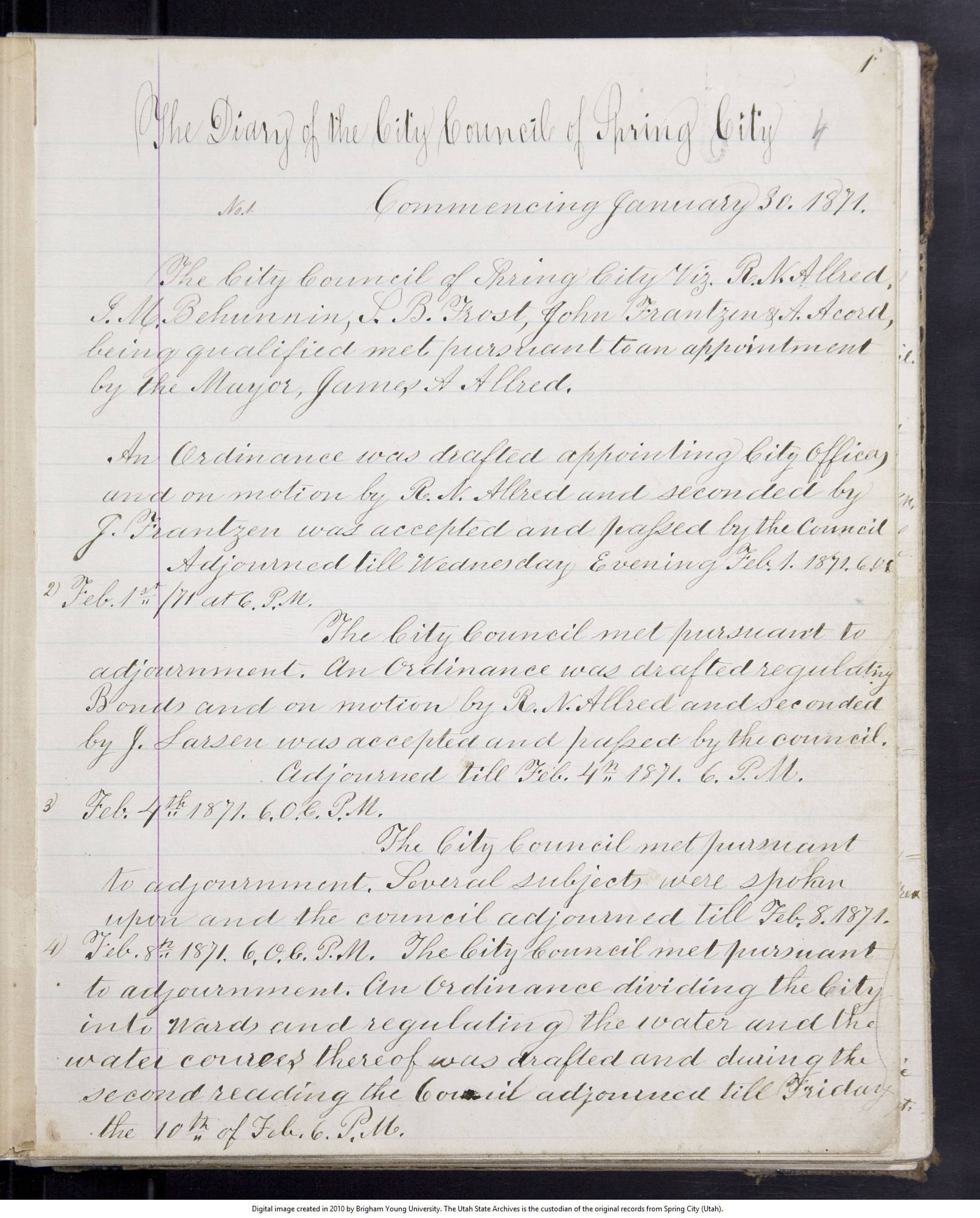Communities as stakeholders in the Utah State Archives
08 October 2019 – Mahala Ruddell
How do you cultivate trust in government institutions like a state archive while working in a place like Utah, populated by dispersed communities who, generally speaking, dislike top-down governance and place a high value on public access to records?

Archivist Mahala Ruddell and records specialist Heidi Steed, members of the Utah Division of Archives and Records Service’s local government team, staffing an information booth at the Utah League of Cities and Towns 2019 Annual Convention. Photo Credit: Lauren Singer Katz
Rural communities throughout Utah trend predominantly Mormon. Mormon culture highly values family ties, genealogy, and community history. Because of this, the Utah Division of Archives and Records Service does not struggle to help these cities and towns understand the importance of preserving and providing access to historical records. We do, however, find some communities hesitant to accept help from the Archives because they fear losing access to historical records. In an effort to improve relationships with these communities, the Archives established a local government program that works directly with communities to collaborate on caring for collections.
Utah is a complex, beautiful state. Originally populated by numerous Indigenous tribes, traversed by Spanish and other European explorers and missionaries since the 1500s, and claimed as Mexican territory, the United States absorbed the territory in the 1840s via aggressive expansionist interests. Utah Mormons’ roots as religious refugees; their experience clashing with federal troops, courts, and lawmakers prior to becoming a state in the 1890s; and persistent belief that the average non-Mormon American does not understand them have fostered a general apprehension toward government institutions—including the State Archives–that persist. Even outside Mormon circles, many in the intermountain west distrust top-down governing initiatives (especially when it comes to land management), as outlined in a 2017 Politico report on the state of planning, development, and the environment.
This affects attitudes about who should manage archives, too. Throughout the US, state-run archives are commonly established by legislatures to preserve the state’s public records. In Utah, the legislature designated the archives as “custodian of all records of permanent or historical value that are not required by law to remain in the custody of the originating government entity” (Utah Code 63A-12-102). In other words, we are mandated to ensure the safe and orderly transfer of historical government records that have met retention requirements to the Division’s repository in Salt Lake City. Geographically dispersed communities throughout Utah sometimes view these transfers as prohibitive. The removal of the records from their communities feels as though we are taking history from the hands of the people who created it.
Aware of these concerns, the Division’s local government program works with Utah municipalities to transfer records transparently and collaboratively. This program consists of three staff members who serve as a contact point for communities seeking help in preserving records and understanding the state mandate, as well as the operation of the Archives. Our model is to travel to communities, meet with stakeholders in person, and offer guidance on the care and preservation of records. And when records are transferred into the custody of the State Archives, it is our job to ensure that communities retain access to these important links to their pasts.

Archivists Alan Barnett and Mahala Ruddell pictured on a visit to Parowan, Utah, during which they and records management specialist Heidi Steed consulted with the Iron County treasurer and met with the local chapter of the Daughters of Utah Pioneers. Photo Credit: Heidi Steed
Here is how the process plays out on the ground: In April 2019, local government records management specialist Heidi Steed received a call from Spring City, a small, historic community in central Utah. City officials were moving to a new building and staff had questions about retention schedules for financial records. Many of the local government team’s initial interactions are through records offers asking these types of retention questions. Within the typical bureaucratic framework, such questions could be addressed by directing records officers to the Division’s website, with business conducted over the phone or by email. In most cases, like that of Spring City, the local government team instead schedules a site visit to look at the records in question and consult in person.
Upon arriving, the team found that Spring City had a large collection of historic records, such as the minutes book pictured below, interspersed with current administrative records. Local officials had many additional questions they weren’t sure how to ask. Heidi Steed and Alan Barnett, archivist for the local government, met with stakeholders in the decision-making process, including city staff, a local historian, and leaders from the local Daughters of Utah Pioneers chapter who run the community’s historical museum. The group worked together to appraise the records, assess preservation priorities, and discuss concerns about access and care. Government-produced historical records were transferred to the State Archives for long-term preservation. The local government team then hand delivered digitized copies of these records to the city, ensuring the community easy and ongoing access. Non-government records were kept in Spring City and given to the Daughters of Utah Pioneers museum.

After meeting with stakeholders in Spring City, the local government team helped track down their earliest city council minutes book (pictured), secure digital copies. We now house the book in our permanent storage repository. [Series 8564, Spring City (Utah), Council Minutes]. Image Credit: Digitized by L. Tom Perry Special Collections, Brigham Young University
In another outreach effort in February 2019, the local government team visited Pleasant Grove, a mid-sized city near Provo. Pleasant Grove manages a collection of historical materials through a historic preservation commission appointed by the city. The Commission contacted the Division looking to learn about resources available to them for the care and preservation of records.
Our team visited in person and spent a day working with members of the Commission on site to review the records and answer questions. Commission members then accepted an invitation to a regional, one-day training on archives and records management. The free training included sessions on archiving fundamentals and an overview of resources offered by the Utah State Historical Records Advisory Board (USHRAB).
The USHRAB is funded by a grant from the National Historic Preservation and Records Commission (NHPRC). Administered by the State Archives, the board is made up of archives and records management professionals from all over Utah. Its mission is to assist public and private non-profit organizations and non-federal government entities in preserving and promoting their historical records collections. The USHRAB hosts training opportunities and provides grant funds to preserve and provide access to archival collection.
Members of the Pleasant Grove Historical Preservation Commission, as well as other training attendees, processed sample collections and learned about establishing collections policies, appraising records, and creating finding aids and other access tools. After the training, the Commission worked with our local government team to submit a grant proposal to the USHRAB for funds to process and re-house its historical records collection.
The local government team and the USHRAB both represent a new model of how the State Archives hopes to serve Utah. Recognizing that bureaucracy can be difficult to navigate and that the geography of the state can limit contact with the Division, the team is hoping to improve the visibility and functionality of the State Archives within rural Utah.
Utah is a large state with a small population. As such, the State Archives is involved with government records management practices such as creating retention schedules, hosting trainings, and providing professional expertise that may be handled on a regional or county level in states with larger populations like California. Utah has found our historical records advisory board to be particularly helpful in reaching rural or underserved communities. Every state and territory has a board, though each state may utilize it differently, or sometimes not at all. Depending on how the board functions, it may serve as a natural bridge to these communities who would benefit from its resources. Grant funding, professionals serving in advisory roles, and regular newsletters are all valuable outreach tools.
Utah’s history and culture both contribute to a general apprehension toward big government. Yet at the same time, both foster a profound appreciation for community and the past. In taking our training, expertise, and financial resources directly to Utah’s towns and cities, the State Archives is building relationships and harnessing that appreciation for good. We aim to serve as partners with these communities in caring for and providing access to their historical records.
~Mahala Ruddell is an archivist at the Utah Division of Archives and Records Service where she primarily works with local government records. She also serves as Executive Secretary for the Utah State Historical Records Advisory Board.



